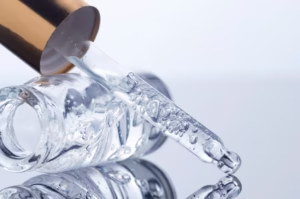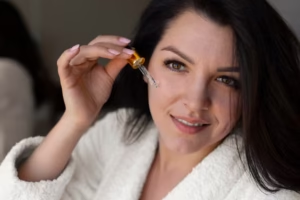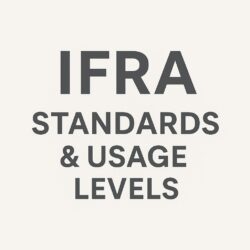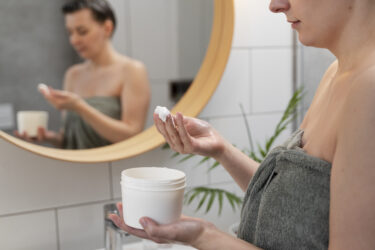The Science Behind Hyaluronic Acid:
Have you ever wondered why hyaluronic acid (HA) is in almost every moisturizer, serum, and sheet mask? Spoiler: It’s not just hype. This superstar ingredient can hold up to 1,000 times its weight in water, making it a hydration powerhouse. But here’s the catch: Not all HA is created equal.
The secret to unlocking its full potential lies in understanding its science and formulation. In this guide, you’ll learn how to choose the right molecular weight, avoid common mistakes, and pair HA with ingredients like niacinamide for next-level results. Let’s dive in!
What Is Hyaluronic Acid?
Hyaluronic acid (HA) is a naturally occurring glycosaminoglycan found abundantly in your skin, connective tissues, and joints, where it helps retain moisture and keeps tissues well-lubricated. It acts as a powerful humectant, drawing water from the environment and binding it to skin cells, ensuring long-lasting hydration.
In addition to its hydrating properties, HA supports skin elasticity and wound healing, making it a key ingredient in both skincare and medical treatments. As a fundamental component of the extracellular matrix (ECM), it contributes to cell regeneration, collagen synthesis, and overall skin health. Due to these benefits, HA is widely used in anti-aging skincare, dermal fillers, and joint therapy to improve hydration, plump the skin, and reduce fine lines.

What Makes Hyaluronic Acid Special?
✔ Superior Hydration: HA is famous for its ability to retain up to 1,000 times its weight in water, making it one of the most effective humectants in skincare (Journal of Clinical and Aesthetic Dermatology, 2014).
✔ Skin Barrier Protection: It forms a moisture-locking barrier on the skin’s surface, reducing transepidermal water loss (TEWL) and preventing dehydration.
✔ Anti-Aging Benefits: Regular use of HA plumps up the skin, reduces the appearance of fine lines, and improves skin elasticity.
If you’re interested in exploring how skincare can be infused with makeup for enhanced beauty, check out this article on skincare-infused makeup.
How HA Levels Decline With Age
Unfortunately, as we age, our natural HA production decreases.
🔹 By the time you reach 30, HA levels begin to drop, leading to drier skin and the first signs of aging.
🔹 By 50, your skin has lost nearly 50% of its natural HA, resulting in wrinkles, sagging, and dullness (Cleveland Clinic).
Different Forms of Hyaluronic Acid in Skincare
Not all HA is the same! Depending on molecular structure and size, different forms of HA offer different benefits:
✔ Sodium Hyaluronate: A salt form of HA that penetrates deeper into the skin for long-term hydration.
✔ Hydrolyzed Hyaluronic Acid: A low-molecular-weight HA designed to penetrate beyond the surface layer and improve elasticity.
✔ Cross-Linked Hyaluronic Acid: A modified HA form used in dermal fillers for plumping and volume restoration.
💡 Pro Tip: If you want the most effective hydration, choose products with a blend of multiple forms of HA for layered moisture.

How Does Hyaluronic Acid Work?
Hyaluronic acid works as a powerful humectant, attracting and binding water molecules to the skin to maintain optimal hydration levels. It can hold up to 1,000 times its weight in water, ensuring a plumper, smoother, and more youthful complexion. However, its effectiveness is highly dependent on molecular weight—larger molecules sit on the skin’s surface, forming a protective moisture barrier.
While smaller molecules penetrate deeper, enhancing hydration at a cellular level. By using a multi-molecular-weight HA blend, you can achieve layered hydration, targeting both the skin’s surface and deeper layers for maximum moisture retention and anti-aging benefits.
Understanding HA Molecular Weights & Their Effects
| Molecular Weight | Penetration Depth | Key Benefits |
| High (1–2M Da) | Surface layer | Forms a protective film, locks in moisture |
| Medium (500k–1M Da) | Upper epidermis | Smooths fine lines, enhances plumpness |
| Low (50–300k Da) | Deep epidermis | Stimulates collagen, improves elasticity |
💡 Best Approach: A combination of high + low molecular weight HA provides both immediate and long-lasting hydration.
5 Pro Tips for Maximum Hydration with Hyaluronic Acid
To get the most out of hyaluronic acid, it’s essential to use the right concentration, pair it with complementary ingredients, and ensure optimal formulation conditions. Here are five expert-backed tips to help you maximize HA’s hydration potential and keep your skin plump and moisturized.
- Optimize the Right HA Concentration
✔ Recommended concentration: 0.1%–2% for most effective hydration.
✔ More than 2% HA can feel sticky or cause pilling on the skin (International Journal of Cosmetic Science, 2018).
💡 Beginner Mistake: Using too much HA without pairing it with other humectants can lead to moisture imbalance.
- Pair HA with Humectants & Occlusives
To maximize hydration, HA works best when combined with:
✔ Humectants (draw water into the skin):
- Glycerin
- Panthenol
- Aloe Vera
- Propanediol
✔ Occlusives (seal moisture into the skin):
- Squalane
- Ceramides
- Dimethicone
- Shea Butter
Example Formula:
A serum with 1% HA + 5% glycerin + 2% squalane provides 48% better hydration than HA alone (Dermatology Research and Practice, 2020).
- Avoid High pH Formulas
✔ HA is most stable between pH 6–7.5.
✔ Avoid pairing with highly acidic ingredients (e.g., pure Vitamin C, AHAs) unless properly formulated.
- Use Stabilized HA in Serums
- HA is sensitive to heat, oxidation, and UV light.
- Fermented HA (e.g., derived from Streptococcus zooepidemicus) has a longer shelf life and better absorption.
- Test for Sensitivity
✔ HA is generally safe for all skin types, but some users (especially in low-humidity areas) report dryness.
✔ Solution: Always apply HA to damp skin and layer it with a moisturizer.

Debunking 3 Hyaluronic Acid Myths
Despite its popularity, hyaluronic acid is often misunderstood, leading to myths that can affect how people use it. Let’s clear up some common misconceptions and reveal the real science behind HA.
Myth 1: “Hyaluronic Acid Dries Out Skin”
✔ Truth: HA needs ambient moisture to work effectively.
💡 Solution: Always apply HA on damp skin or layer with a hydrating toner.
Myth 2: “All Hyaluronic Acid Is Vegan”
✔ Truth: Traditional HA was extracted from rooster combs.
💡 Modern alternatives: Today, most HA is vegan-friendly, produced via bacterial fermentation.
Myth 3: “Higher HA Concentration = Better Results”
✔ Truth: More than 2% HA doesn’t improve hydration—it can cause pilling and tackiness.
💡 Best Practice: Stick to 0.1%–2% for optimal results.
As you address HA loss, consider incorporating other potent ingredients like retinol into your routine for enhanced anti-aging benefits. Discover how retinol can benefit your skin here.
Top 3 Hyaluronic Acid Products
With so many hyaluronic acid products on the market, choosing the right one can be overwhelming. Here are three top-rated options known for their effective hydration, skin compatibility, and proven results.
- The Ordinary Hyaluronic Acid 2% + B5
✔ Multi-weight HA for deep hydration.
✔ Vitamin B5 repairs the skin barrier.
✔ Provides 72-hour moisture retention.
- Neutrogena Hydro Boost Gel-Cream
✔ Uses cross-linked HA for long-lasting hydration.
✔ Lightweight, non-greasy texture—great for oily & combination skin.
- COSRX Advanced Snail 96 Mucin Power Essence
✔ Infused with 96% snail mucin + HA for intense hydration.
✔ Helps repair damaged skin & restore elasticity.
FAQs:
Q1: Can HA Cause Breakouts?
✔ No, HA itself is non-comedogenic.
💡 Watch out for: Added fragrances, alcohols, or silicones in HA serums that might trigger acne.
Q2: Can I Use HA with Retinol?
✔ Yes! HA helps counteract retinol’s drying effects.
💡 How to Use: Apply HA first, let it absorb, then apply retinol.
Q3: Is HA Safe During Pregnancy?
✔ Topical HA is 100% safe for pregnancy and breastfeeding.
⚠ Avoid HA dermal fillers unless approved by your doctor.
Final Takeaways
✔ Use multi-weight HA for hydration at all skin layers.
✔ Pair HA with humectants & occlusives to lock in moisture.
✔ Stick to 0.1%–2% concentration for the best results.
Conclusion
Hyaluronic acid is a skincare powerhouse known for its deep hydration, anti-aging benefits, and skin-repairing properties. Whether used in serums, creams, or injectables, it plays a vital role in maintaining a youthful, plump complexion.
By choosing the right molecular weight and pairing it with complementary ingredients, you can maximize its effectiveness for healthier, well-hydrated skin. Incorporating HA into your daily routine is a simple yet powerful way to achieve long-lasting moisture and a radiant glow.



